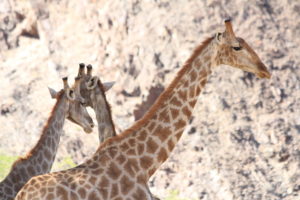As appearing in WARNERCNR.Source.colostate.edu | July, 2021 | by Mary Guiden
Bats and behemoths: How large mammals may help bat diversity in the world’s oldest desert
Theresa Laverty had a lot of flexibility in deciding what she would study for her doctoral dissertation when she arrived at Colorado State University, thanks to a graduate research fellowship from the National Science Foundation. After many conversations with her advisor, Professor Joel Berger, she decided to look at the effects of herbivores – or animals that eat plants – on other levels of the food web in the Namib Desert in southwestern Africa.
Laverty knew that these animals, specifically the “mega” herbivores – elephants, giraffe and rhinoceroses – impact bodies of water in desert ecosystems. But what other levels of the food web are impacted by these large mammals?
Now a postdoctoral fellow in the Department of Fish, Wildlife and Conservation Biology at CSU, Laverty found that these large mammals may indirectly benefit desert bat diversity and activity.
A new paper from her research, “Indirect effects of African megaherbivore conservation on bat diversity in the world’s oldest desert,” was recently published in Conservation Biology. Berger is a co-author of the paper.
Laverty recently spoke with SOURCE about her interest in these animals and what it was like to conduct research in the middle of the night with some of the world’s largest mammals.
Q: How did you decide to focus on bats in this research?
Laverty: Conservation efforts are usually dedicated toward big charismatic species. The Namib Desert is unique in that it is home for a full suite of megaherbivores and carnivores. While these species are well studied, we know so little about bats in Namibia and most of Africa.
On the positive side, the conservation of megaherbivores may be indirectly benefiting bats, but we do not know if this will be true in the long-term. It took more effort than I care to admit uncovering new information about these bat species, and to see how these large mammals may benefit small, often overlooked bats.
Q: What are some things about bats that people might not know?
Laverty: Bats are extremely diverse. While most bats feed on insects, where they forage can differ. For instance, free-tailed bats in the Namib feed above vegetation. They almost look like whales, flying fast with their mouths open. Other bats that are more maneuverable will pick insects off vegetation. We even captured – and released – two species of fruit bats in the Namib Desert at sites with fruiting fig trees or date palms.
Q: How did you study these animals and insects in the desert?
Laverty: I observed bats using acoustic detectors over waterholes and mist netting, using a net that is nearly invisible to flying bats. For my dissertation work, I was able to track which bats were present over 25 waterholes in the Namib Desert over 1.5 years that I was in the field.
During some of those months, I created transects or paths, moving away from bodies of water. I would remove all the dung from megaherbivores in those belts and identify it, getting an index of how much herbivore activity was present each month. That told us how much these animals were depending upon these bodies of water.
Q: What were your key findings?

In the dry season, when all the wildlife is concentrated around these permanent bodies of water, we found an indirect, positive relationship between megaherbivores on bats. These large herbivores may have been stimulating plant growth through their browsing, which positively affected vegetation productivity.
In turn, this had a positive effect on bat diversity and activity, particularly that of less maneuverable, open-air foraging bats. We think this may be due to elephants restructuring vegetation by pulling down branches near waterholes, providing more access for these bat species.
In the wet season, when wildlife are released from the need to concentrate around these permanent bodies of water, there is more vegetation and ephemeral water available to herbivores. We did not find any significant effects or impacts of megaherbivores on bats.
Q: What else would you like to highlight about this research?
Laverty: Many Africans are poor and do not always choose to live among elephants and other large wildlife. The elephants occasionally break water pipes and destroy small-scale agriculture projects, threaten humans and livestock.
Conservation efforts for these large species must continue but it is not always easy when you are living as a shepherd or someone who raises livestock for a living in these small communities in a desert. As another part of my dissertation work, I interviewed local pastoralists in this region and found them to be relatively tolerant of living with megaherbivores.
At least for now, it appears that the conservation of megaherbivores may be indirectly benefiting bats in this ecosystem. If these conservation efforts recognize the need for human and livestock safety, this appears to be a short-term solution for protecting the Namib’s bats – at least until more bat research is conducted in this region.
Q: Where will your research take you next?
Laverty: I just completed a two-year postdoctoral position at CSU focused on the population ecology of migratory, nectarivorous long-nosed bats at the northern extent of their range in New Mexico. We were specifically interested in how the peak of the bat migration compared to local food availability of Agave nectar for these species, which are well-known for pollinating the plants that give us tequila and mezcal.
During my time off this summer, I am hiking the Colorado Trail. This fall, I will begin a postdoctoral position at the University of Chicago where I will be working with a team of disease ecologists on the conservation of bat communities in Madagascar.